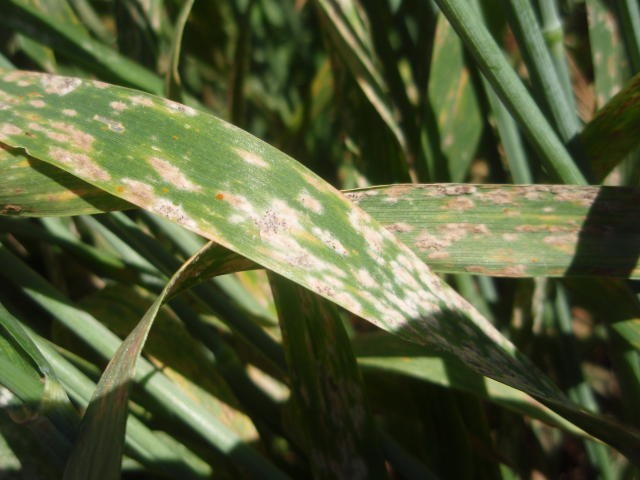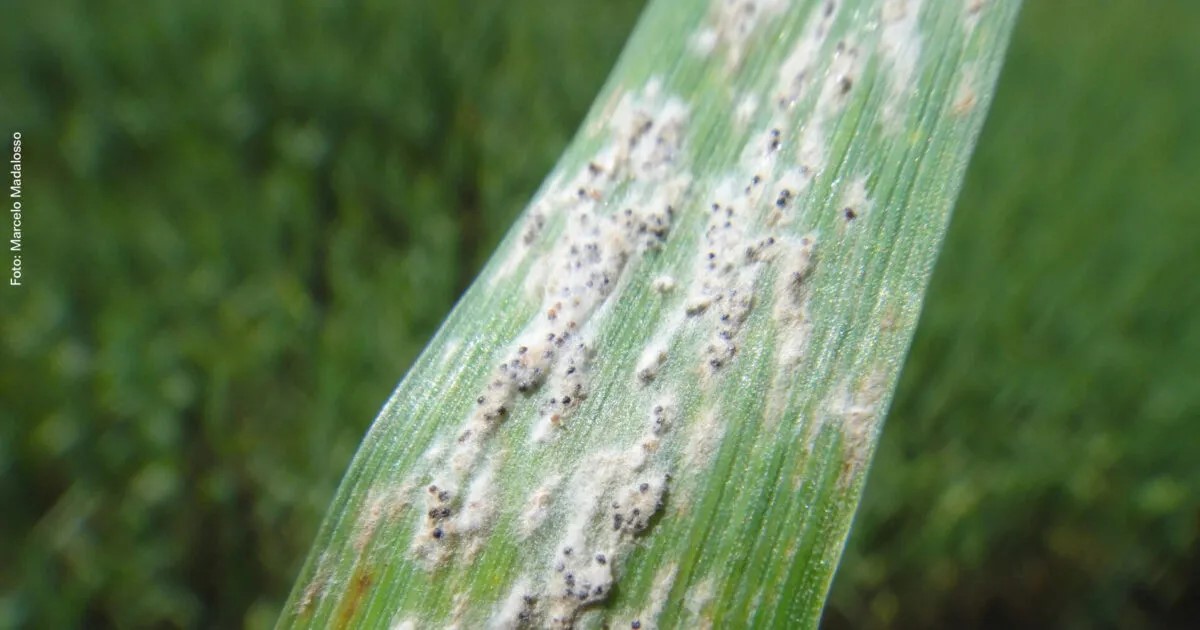Wheat (Triticum spp.) continues to be an important alternative for producers during the winter harvest in southern Brazil. In addition to representing an opportunity for additional income for producers and contributing to diversification and straw production in the no-till system, wheat is also an agronomic tool in crop rotation systems. Its introduction helps break the cycles of pests, diseases, and weeds in crops. However, to ensure the success of the harvest, it is essential to invest in good management practices from the beginning. Among the main challenges faced in the early stages of crop development is powdery mildew, a fungal disease that can seriously compromise plant development soon after emergence (LAU et al., 2020).
Powdery mildew, caused by the fungus Blumeria graminis f. sp. tritici, is a foliar disease that reduces grain yield and quality. Damage varies according to the region, climatic conditions, cultivar susceptibility, and plant development stage at the time of infection. According to Reis et al. (1997), the reduction in grain yield can range from 10% in more resistant cultivars to 62% in more susceptible ones. The disease manifests itself with greater intensity in regions with milder and drier climates, conditions common during the fall and early winter in the South of the country, a period in which most wheat crops are in the germination and emergence phase. With relative air humidity between 85% and 100% and temperatures between 15°C and 22°C, powdery mildew spreads easily in environments with little rainfall and frequent dew (CABI, 2020). These factors make its occurrence more difficult to predict and its control more challenging.
Symptoms
The typical manifestation of powdery mildew is the emergence of structures such as mycelium and conidia, which are grayish-white in color and look like fine dust. They usually appear on the upper surface of wheat leaves (figure 1). Under favorable weather conditions, these colonies can form on seedlings soon after germination. In cases of intense infection, the fungus can reach all green areas of the plant located above the soil, including the stem, ear and awns. As they grow, the colonies can expand and merge, covering large areas of the plant. In these later stages, they acquire a grayish coloration and develop small dark structures, called cleistothecia, which function as resistance structures for the fungus (figure 2).

Figura 1 (fonte: Embrapa Trigo)

Figura 2 (fonte: Marcelo Madalosso).
Control methods
Although powdery mildew is not a seed-borne disease, seed treatment plays an important role in the initial phytosanitary management of crops. Seeds treated with fungicides contribute to the effective control of soil and seed pathogens, favoring vigorous emergence and uniform establishment of the crop. This good initial start allows plants to face early attacks of diseases, such as powdery mildew, with protection (EMBRAPA, 2022).
In this context, one of the protective measures is the use of specific fungicides for this disease focused on seed treatment. Sistiva® is a fungicide with protective action, as it acts to inhibit spore germination and the development and penetration of germ tubes. It contains the fluxapyroxad molecule, which belongs to the carboxamide group and has a systemic and prolonged residual action. Its formulation provides protection not only against early-cycle diseases, such as Fusarium and Helminthosporium, but also provides a suppressive effect on foliar diseases, including powdery mildew. This reduces the initial pressure of the disease and contributes to plant protection until foliar application, optimizing chemical management throughout the cycle (BASF, 2021).
Therefore, although seed treatment does not completely eliminate the risk of powdery mildew, the use of products such as Sistiva® represents an advance in the preventive and integrated control of the disease. Its adoption, combined with the use of resistant cultivars, crop monitoring and foliar applications at the correct time, makes up an efficient strategy for managing powdery mildew in wheat.
Conclusion
Success in wheat production in Southern Brazil depends on careful management from the early stages of the crop, especially in combating diseases such as powdery mildew, which can severely compromise crop development and productivity, as occurred in the 2024 harvest. Understanding the climatic factors that favor the disease, combined with early identification of symptoms, is essential for making assertive decisions in the field.
Among the management strategies, the most important is the treatment of seeds with systemic fungicides, which offers long-lasting and effective protection during the initial start of the crop. In addition, it is important to always remember that monitoring the crop and applying foliar sprays at the onset of symptoms are also essential for successful management. When integrated with other practices, such as the use of resistant cultivars and constant monitoring of the crop, powdery mildew control becomes more efficient and sustainable, contributing to the health of the crop and maximizing the productive potential of wheat.
Text written by Caetano Rocha and Eduarda Seger da Silva Pinheiro, students of the Agronomy course at UFSM, Frederico Westphalen campus, members of the Tutorial Education Program - PET Agricultural Sciences, under the supervision of the tutor, Professor Dr. Claudir José Basso.
Bibliographic References:
CABI. Blumeria graminis (powdery mildew of grasses and cereals). In: Invasive Species Compendium. Wallingford, UK: CAB International, 2020.
LAU, D. et al. Major wheat diseases in southern Brazil: diagnosis and management. Embrapa Trigo-Technical Communication (INFOTECA-E), 2020.
REIS, E. M.; CASA, R. T.; HOFFMANN, L. L. Effect of powdery mildew, caused by Erysiphe graminis f. sp. tritici, on wheat grain yield. Fitopatologia Brasileira, v.22, p.492-495, 1997
BASF. Sistiva® – Wheat and barley seed treatment. 2021. Available at: https://www.agriculture.basf.com/br/pt/Produtos/Visao-geral/Sistiva.html. Accessed on: May 16, 2025.
EMBRAPA. Wheat: technical recommendations for southern Brazil – 2022 Harvest. Passo Fundo: Embrapa Trigo, 2022. 286 p. (Documents, 257).
Cover photo: Leila Costamilan/divulgação Embrapa Trigo




